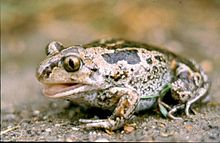- Pelobates fuscus
-
Pelobates fuscus 
Pelobates fuscus fuscus 
Pelobates fuscus insubricus Conservation status Scientific classification Kingdom: Animalia Phylum: Chordata Class: Amphibia Order: Anura Suborder: Mesobatrachia Family: Pelobatidae Genus: Pelobates Species: P. fuscus Binomial name Pelobates fuscus
(Laurenti, 1768)Subspecies P. fuscus fuscus
P. fuscus insubricusSynonyms [2] - Bombinator fuscus Fitzinger, 1826
- Bufo fuscus Laurenti, 1768
- Pelobates fuscus fuscus Mertens, 1923
- Pelobates fuscus insubricus Crochet and Dubois, 2004
- Pelobates fuscus insubricus Mertens, 1923
- Pelobates fuscus var. lividus Koch, 1872
- Pelobates fuscus var. orientalis Severtsov, 1913
- Pelobates fuscus vespertinus Crochet and Dubois, 2004
- Pelobates fuscus Wagler, 1830
- Pelobates praefuscus Khosatzky, 1985
Pelobates fuscus is a species of toad in the family Pelobatidae, native to an area extending from Central Europe to Western Asia. It is commonly known as the Common Spadefoot, Garlic Toad, the Common Spadefoot Toad and the European Common Spadefoot.
The common spadefoot grows to a length of approximately 6.5 centimetres (2.6 in) for males and 8 centimetres (3.1 in) for females. The skin colouration varies depending upon habitat, gender and region, but is usually light-grey to beige-brown on the dorsal surface. The skin is mottled by darker marks that differ between individuals. The belly is white, sometimes with grey mottling. Albino specimens have been observed.
Two subspecies are traditionally recognised: Pelobates fuscus fuscus (from central Europe) and Pelobates fuscus insubricus (from N. Italy). In reality there is no physical or behavioural character allowing to distinguish these supposed subspecies. A recent study showed that there is no haplotype segregation for the populations of N. Italy, that, therefore, are not to be ascribed to a different subspecies [3]. Haplotypes from some N. Italian valleys are very characteristic and support a different conception in terms of conservation: not for a different taxonomic position but, instead, for a peculiar differentiation. Populations from eastern Europe appear sufficiently different to warrant a possible species status (Pelobates vespertinus).
When alarmed, it emits a very loud call (alarm call) and it can exude a noxious secretion which bears a garlic odour, hence the common name "garlic toad".
References
- ^ Aram Agasyan, Aziz Avisi, Boris Tuniyev, Jelka Crnobrnja Isailovic, Petros Lymberakis, Claes Andrén, Dan Cogalniceanu, John Wilkinson, Natalia Ananjeva, Nazan Üzüm, Nikolai Orlov, Richard Podloucky, Sako Tuniyev, Uğur Kaya (2008). Pelobates fuscus. In: IUCN 2008. IUCN Red List of Threatened Species. Downloaded on January 31, 2010.
- ^ Darrel Frost. "Pelobates fuscus". Amphibian Species of the World 5.3, an Online Reference. The American Museum of Natural History. http://research.amnh.org/vz/herpetology/amphibia/names.php?taxon=fuscus&family=&subfamily=&genus=Pelobates&commname=&authority=&year=&geo=0&dist=&comment=. Retrieved January 31, 2020.
- ^ Angelica Crottini & Franco Andreone (2007). "Conservazione di un anfibio iconico: lo status di Pelobates fuscus in Italia e linee guida d’azione". Quad. Staz. Ecol. civ. Mus. St. nat. Ferrara 17: 67–76. http://www.francoandreone.it/docs/Crottini_Andreone_Pelobates_iconico.pdf.
Categories:- IUCN Red List least concern species
- Frogs by classification
- Amphibians of Europe
- Amphibians of Asia
- Pelobates
- Animals described in 1768
- Amphibian stubs
Wikimedia Foundation. 2010.

